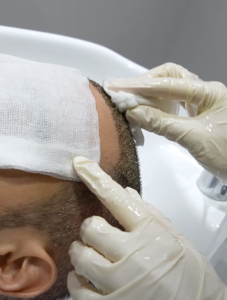Hair transplantation is a transformative journey, and the post-operative care during the first six months plays a vital role in ensuring the success of the procedure. By following your doctor’s instructions and adhering to best practices, you can achieve optimal results and a healthy recovery. Here’s a detailed guide to navigating the recovery process, including the critical stages and essential care tips.

Week 1: Protecting the Transplanted Area
The initial week after your hair transplant is crucial for the grafts to settle securely. During this period:
- Sleep Position: Sleep with your head elevated to minimize swelling. Use a neck pillow to avoid contact with the grafted area.
- Avoid Touching the Scalp: It’s important to keep your hands away from the treated area to prevent infection or displacement of grafts.
- Medications: Take prescribed antibiotics and painkillers as directed by your doctor to reduce discomfort and prevent infections.
- Washing Instructions: Follow your clinic’s specific instructions for washing your hair. Typically, a gentle saline spray or a special shampoo is recommended to keep the area clean.
Weeks 2–4: Shedding Phase and Continued Care
As you approach the second week, you might notice shedding of the transplanted hair. This is a normal part of the healing process called “shock loss.”
- Be Patient: Understand that shedding is temporary and a sign that the hair follicles are entering a new growth phase.
- Avoid Intense Activities: Refrain from strenuous physical activities that might cause sweating or increase blood pressure in the scalp.
- Moisturization: Use any recommended moisturizers to prevent dryness and itching as your scalp heals.
Months 2–3: New Hair Growth Begins
By the second month, the dormant hair follicles will start to show signs of new growth. This stage can be exciting, but it’s essential to remain cautious.
- Protect Your Scalp: Wear a hat or sunscreen when exposed to the sun to protect the sensitive scalp from UV rays.
- Gentle Hair Care: Use mild shampoos and avoid harsh chemicals to maintain scalp health.
- Balanced Diet: Focus on nutrient-rich foods, including proteins, vitamins (especially biotin), and omega-3 fatty acids, to promote hair health.
Months 4–6: Visible Improvements
Around the fourth month, you’ll notice a significant improvement in hair density and texture. The transplanted hair will begin to blend naturally with your existing hair.
- Resume Physical Activities: By now, most patients can return to regular exercise routines. However, consult your doctor before resuming activities like swimming or weightlifting.
- Regular Follow-ups: Schedule check-ins with your clinic to monitor progress and address any concerns.
- Scalp Massage: Gentle massages can help improve blood circulation to the scalp, supporting healthy hair growth.
Products to Support Recovery
Using the right products can make a significant difference in the healing process:
- Mild Shampoos: Opt for sulfate-free shampoos that cleanse without irritating the scalp.
- Nourishing Serums: Hair growth serums enriched with vitamins and peptides can support follicular health.
- Anti-inflammatory Sprays: These sprays help reduce redness and soothe the scalp during the healing phase.
What to Avoid During Recovery
To ensure the best results, steer clear of:
- Smoking, which can slow healing and affect graft survival.
- Excessive alcohol consumption, as it can impact blood flow and recovery.
- Hair styling tools like blow dryers or straighteners for at least 6 months.
Conclusion
The first six months after a hair transplant are a period of adjustment and growth. By following these expert care tips, you can maximize the success of your procedure and enjoy the full benefits of your new hair. Remember, patience and consistency are key to achieving long-lasting, natural-looking results.
Have more questions about hair transplant recovery? Contact Hairneva today to consult with our specialists and start your journey to a fuller, healthier head of hair.
